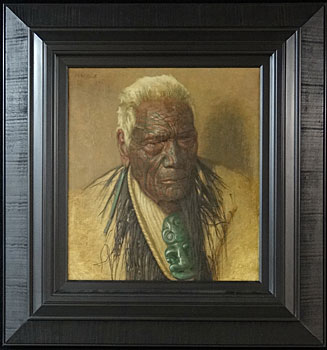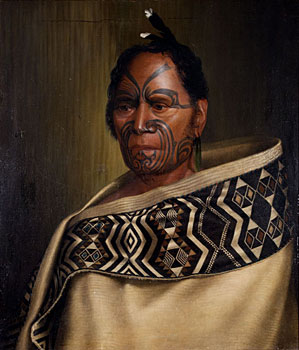Charles Frederick Goldie And The Value Of The Secondary Market Fri, 29 Apr 2016

On April 6, Charles Goldie's magnificent 1941 portrait of Wharekauri Tahuna was sold by International Art Centre for $1.3m, making it the most expensive work of art to ever have been sold at auction in New Zealand. The energy and national excitement generated by this record-breaking sale is still palpable and will forever be an important milestone in New Zealand's art historical narrative.
From a market-based perspective, it is obvious that the sale of Wharekauri Tahuna is testament to New Zealand's burgeoning art market potential. More significantly, however, it represents the maturation of our collective national relationship with Charles Frederick Goldie, and speaks to the inherent value of Goldie's art as a mainstay of our cultural currency.
In considering the various factors which have culminated in such a robust market appetite for Goldie's paintings, the role of the secondary (auction) market as arbiters of taste and value is paramount. International Art Centre is proud to have played a long-standing role as the leading secondary market vendor for Goldies, and as the single major influence in the Goldie market to date. Since 1971, International Art Centre have spearheaded growth in the market with a number of record-breaking Goldie sales. The success of the current market is in many ways the product of this unique and productive relationship which has linked International Art Centre's boundary-pushing sales with the artist's work over the last 45 years. Extrapolating some of the highlights of these sales over the decades will offer insight into the machinations and motivations of this market:
Going back to the 1980s, it is interesting to note that despite the overall economic strength and market stability of this era (prior to 1987), prices attained for Goldie's work at auction were not in accordance with the corresponding climate of financial buoyancy. This can be linked to the political and reputational discord being experienced by Goldie's work at the time. For the market to evolve from this point, a certain academic endurance and culturally-disclaiming acceptance needed to crystallise.
Further evidence of the Goldie market's ability to rebut the economic climate can be found in International Art Centre's 2008 sale of the magnificent 1933 portrait of Hori Pokai. This realised a record price of $454,000, well in excess of its $240,000 - $280,000 estimate, and standing in glorious defiance of the imminent economic downturn: a testament in its own right to the bullishness of the art market. The painting, also known as Sleep 'tis a Gentle Thing, is an iconic work, and its wholehearted reception by the buying public affirmed the increasingly unshakeable nature of Goldie's market.
In considering the 'value' of art, there is a tendency to indulge the notion that art historical truth and reputation are qualities which exist independently of time, place and market fluctuations, and that the financial value of works by major artists - such as Goldie - is derived from this higher academic authority. However, it would be inaccurate to presume that the market appetite for Goldie's works has been informed by, and followed the trajectory of, his academic reputation.

Rather than responding in a delayed manner to the art historical or institutional climate, the market for Goldie's work in fact grew as a result of, and in the context of, a process of collaborative exchange between vendor and institution. The fluidity of this market / institutional relationship is perfectly exemplified in the 1992 sale by International Art Centre of two important Goldie works, Darby and Joan and The Widow, to the National Art Gallery for the sum of $900,000 plus GST. Not only did the sale serve to affirm Goldie's commercial worth, but it also amplified his institutional presence and recognition, solidifying the visibility of his position in the New Zealand art historical canon. In this sense, and particularly with consideration to the Goldie market, it is important to realise that the relationship between market value and 'inherent' artistic value is dynamic, and the two are inextricable.
Two years after the sale of Hori Pokai, in 2010, the scene was once again set at International Art Centre as a record price of $573,000 was achieved for the sale of Forty Winks. This sale is of particular interest insofar as it offers an important point of consideration regarding the value of provenance. The portrait is a splendid work, exhibiting the very finest aspects of Goldie's technical expertise, and is the only known work to have been painted of the sitter Rutene Te Uamairangi. The large scale and superb technical detail of the work magnificently showcase qualities highly sought-after in Goldie's work. Furthermore, the work came from the collection of Dame Kiri Te Kanawa, affording it a significant additional aspect of cultural value, the elusive aura of its provenance drawing both on the celebrity status and authoritative cultural endorsement implied by the fact of its previous owner.
One further interesting aspect of the cultural-economic phenomenon which constitutes the market for Goldie's work relates to the buying public's unwavering commitment to the totality of the artist's oeuvre. An increase in demand and more profound appreciation of Goldie's work in recent years has prompted a dedicated approach to the acquisition of his paintings in a manner which extends far beyond a tokenistic mode of acquisition, or trophy collecting. This all-encompassing rigour and enthusiasm for the artist's work has been evidenced by two key sales in particular. In 2012, International Art Centre's momentous sale of Goldie's 1892 Kawhena achieved what was, at the time, another record price of $732,800. It is important to note that this work, Goldie's first portrait of a Maori kaumatua, had never before been presented to the market, and did not carry the same degree of celebrity as, say, Forty Winks. Moreover, the highly-polished formal attributes of Kawhena are representative of Goldie's early technique, and do not necessarily align closely with those most readily-identifiable and classically sought-after aspects of his work. The work is exquisite, and the fact that the market responded so eagerly to a previously unknown, arguably untraditional painting of Goldie's demonstrates a genuine desire to celebrate the complexity and diversity of his artistic output, rather than just perfunctorily engaging with his trademark style.
This brings us back to the most recent sale of Wharekauri Tahuna, which stands in circular witness to the sale of Kawhena, book-ending Goldie's career as the last-known portrait to have been completed, and once again setting a record for the artist. Notably, this was accompanied in the same sale by an outstanding Goldie drawing which achieved an exceptional hammer price of $80,000 against an estimate of $15,000 - $25,000. Looking ahead from the point of this watershed moment in the New Zealand art market history, the sale of Wharekauri Tahuna will without a doubt pave the way for the market to continue to flourish and break bold new territory in years to come.
